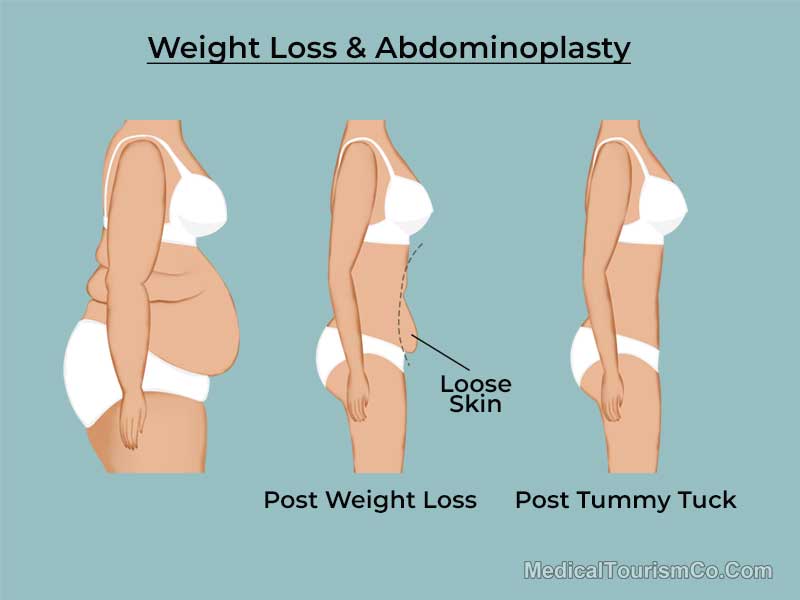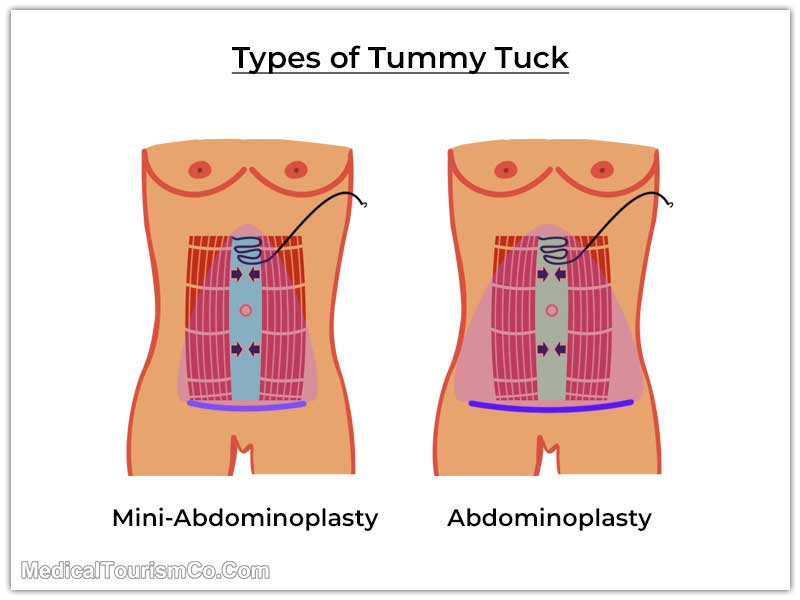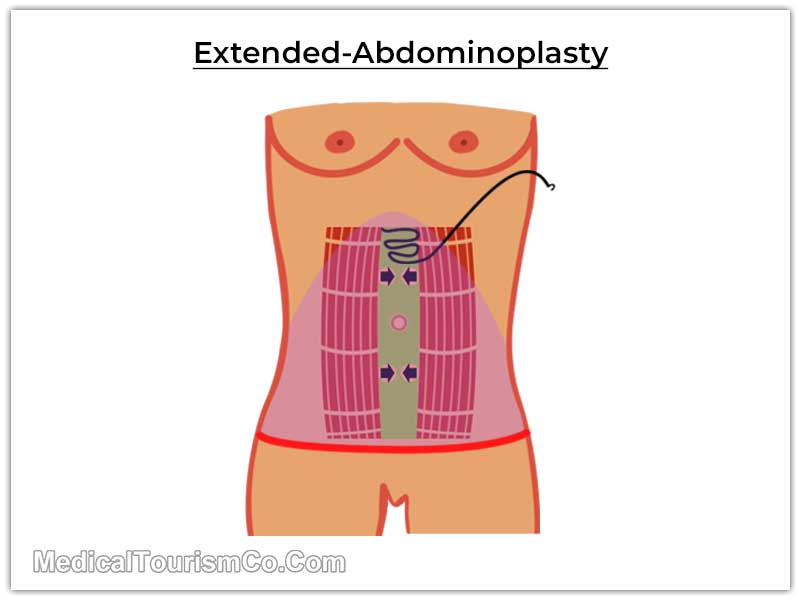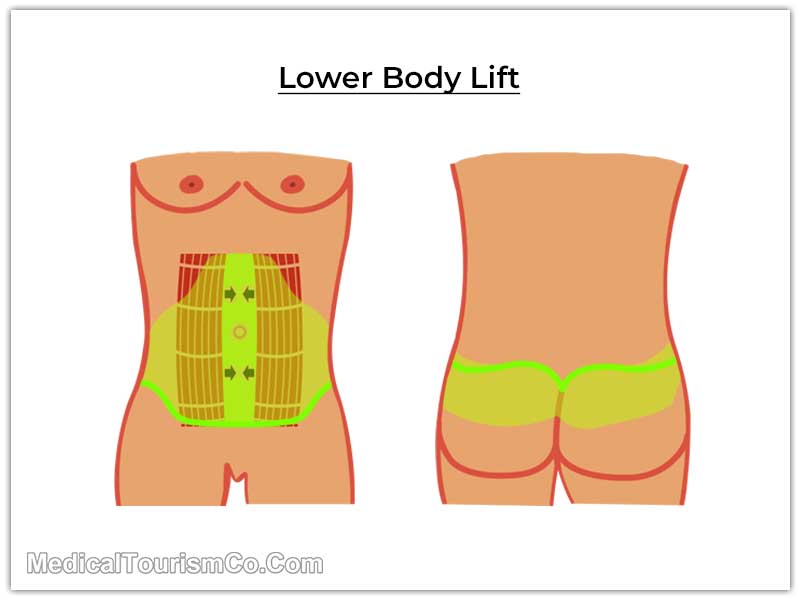Medically Reviewed By: Dr. Anne Saidu (MD), Dr. Suresh Koneswaran (MD, FACC)
Tummy Tuck in Tijuana – Mexico
Are you unhappy with the appearance of your abdomen? A tummy tuck is a surgical passport to a flat and firm belly. It can tighten a flabby tummy, resulting from weight fluctuations, pregnancy, or age.

Main Reasons for Flabby Tummy
You can restore your self-confidence with an affordable tummy tuck in Tijuana, Mexico.
According to a survey by the International Society of Aesthetic Plastic Surgery (ISAPS),1 Mexico ranks among the top five countries in the world based on the number of procedures performed annually.
Tummy Tuck in Mexico Review
How Much is a Tummy Tuck in Tijuana, Mexico?
A traditional tummy tuck costs around $5,000 in Tijuana. The American Society of Plastic Surgeons reports that patients pay about $6,000 on average for the procedure in U.S.2
The abdominoplasty cost can widely vary, and the average fee does not include expenses, such as anesthesia and operating room facilities in the U.S.
Weight Loss and Abdominoplasty
Here is a price list of the abdominoplasty procedures you can get done in Tijuana:
| Tummy Tuck Options | Costs in Tijuana |
|---|---|
| Tummy Tuck | $5,500-6,500 |
| Tummy Tuck + Breast Lift | $7,500 |
| Tummy Tuck + Arm Lift | $8,500 |
| Tummy Tuck + Breast Lift + Implants | $8,000 |
| Tummy Tuck Fleur de Lys | $7,500-8,500 |
Note: Prices are subject to change. The surgeon will provide a final quote after reviewing the health questionnaire and photos
These packages include the pre-surgery appointment with the doctor, anesthesiologist fee, surgeon’s fee, medical-grade compression garments, bloodwork, medication, and all post-surgery checkups.
More Package Inclusions:
- Bilingual patient coordinator
- 1-night stay at the clinic
- Transportation from hotel to clinic and back
Why the Price Difference?
- The cost of living in Mexico is lower than in the U.S. and Canada.
- Staff wages, office rent, and other overheads are lower in Mexico than in the U.S. and Canada.
- Surgeons in Mexico do not have to pay for malpractice insurance, unlike their American counterparts.
Tummy tucks represent 7% of all surgical procedures done in 2017. 3
Why Choose Abdominoplasty in Tijuana
Proximity: Our clinics are situated in the border city of Tijuana, Mexico. It is only 17 miles from San Diego, CA.
No Wait Times: You can obtain appointments for your plastic surgery without any waiting period involved.
Highly Competent Plastic Surgeons: We work with the most renowned plastic surgeons in the Mexican border city.

Dr. Katheryn Solis( LIMARP, Bariatric )
Dr. Katheryn Solis is a plastic surgeon. She specializes in facial rejuvenation, breast augmentation, and facial and body contouring.
Dr. Solis is certified in chronic wound management, traumatic hand care and burn treatment.
She also has expertise in body contouring for patients who have experienced massive weight loss.
Education
National Autonomous University of Mexico
Memberships
- American Society of Plastic Surgeons
- International Society of Aesthetic Plastic Surgery
- Mexican Society of Plastic and Reconstructive Surgery

Dr. Javier Garcia( Dr. Javier Garcia )
Dr. Javier Garcia is a leading plastic surgeon in Tijuana, Mexico, certified by the CMCPER
He holds diplomas in Microsurgery and Reconstructive Surgery from Davies Medical Center and Stanford Medical Center, US.
He has also lectured on plastic and aesthetic surgery both in Mexico and internationally.
Education
Universidad Nacional Autonoma de Mexico
Memberships
- American Society of Plastic Surgeons
- Association of Plastic Surgery of Baja California
- Iberoamerican Federation of Aesthetic and Plastic Surgery
State-of-the-Art Clinics: We have tied up with the top plastic surgery center in Tijuana to provide you with the quality treatment you are looking for.

Accredited three times by the SRC as an International Center of Excellence, LIMARP is a top facility for bariatric surgery.
It is known for its rigorous standards and dedication to helping patients achieve their weight loss goals.
- 20+ Years of Experience
- SRC Certified
- MGCH Certified
Tummy Tuck Mexico Reviews
Sarah from Saskatchewan, Canada talks about her breast augmentation and tummy tuck surgery in Tijuana, Mexico.
Patient Testimonial: Breast Augmentation and Tummy Tuck in Tijuana, Mexico
What is a Tummy Tuck?
If you have stubborn flab or excess skin on your tummy which refuses to respond to exercise or diet, you may consider a tummy tuck.
Abdominoplasty or a tummy tuck flattens your midsection by tightening the abdominal wall muscles and removing extra skin and fat tissue.
This cosmetic surgery flattens the abdomen in patients who require improved muscle tone which cannot be achieved with liposuction or exercise alone.
Tummy Tuck Tijuana Mexico Before After
A tummy tuck is not the same as liposuction, although you may choose to get liposuction along with this procedure.
It is not a weight loss treatment, but rather a contouring procedure.
Types of Tummy Tucks
There are four primary versions of the tummy tuck. Your surgeon will recommend the type depending on the extent and location of excess skin.
Patients who get a full tummy tuck want to resolve issues of general roundness and excess skin.
Classic tummy tucks (also referred to as full tummy tucks) are done when patients want to address the full length of the abdominal wall. This surgery addresses both the sections above and below their belly button.
During this procedure, the incision is made across the lower abdomen from hip to hip, allowing the surgeon to access the underlying tissues.
The plastic surgeon will then contour the skin, tissue, and muscle as required. The belly button is also removed and re-positioned.
Mini and Normal Abdominoplasty
This procedure is ideal for people who want to rid their bellies of a pooch or stretch marks in the lower abdominal region only.
A mini tummy tuck (also referred to as partial abdominoplasty) is less invasive than a full tummy tuck.
During this procedure, the incision is generally 3-5 inches long. It is much smaller but still gives the surgeon access to the necessary tissues and muscles.
The scar can be easily hidden by underwear and bikini bottoms.
The recovery time is faster in this particular tummy tuck as the incision is small and the repositioning of the belly button is not required.
This plastic surgery is usually performed on people who have excess fat deposits or love handles.
It is ideal for those patients who have had multiple pregnancies or have lost lots of weight, either through diet and exercise or through weight loss surgery.
Extended-Abdominoplasty
The goal is to address the abdomen while simultaneously targeting the flanks and hips.
In an extended tummy tuck, the incision extends around the hips to the back. The surgeon will remove excess skin from the upper and lower abdominal region as well as the flank.
Through this operation, one can avoid the formation of “muffin tops” or side bulges that form in a standard tummy tuck or liposuction.
According to renowned plastic surgeon Dr. Joseph P Hunstand’s book, Atlas of Abdominoplasty, “Choosing to perform an extended as opposed to a full abdominoplasty reduces the need for future revisions...”
It is more extensive than a standard tummy tuck. It’s usually performed on patients who have lost a huge amount of weight due to gastric bypass or another type of bariatric surgery.
These individuals are often left with excess skin not only in the abdominal region but in the back and flanks as well.
The circumferential body lift technique (also known as a lower body lift) flattens the abdomen like a tummy tuck and at the same time lifts the lateral thighs, flank, back, and buttocks.
Lower Body Lift
The surgeon makes an incision that spans the entire circumference of the patient’s torso. Then, the doctor removes the excess skin/fat and tightens the muscles. The outer thighs and buttocks are also lifted, and a new navel may be created.
Tummy Tuck was the 5th most popular cosmetic surgery in the U.S. in 2017.4
Are you an Ideal Candidate?
The ideal candidates for tummy tucks are those who:
- Lack abdominal tone
- Have loose, excess or hanging skin on the belly
- Maintain a stable body weight
- Are physically healthy
- Are non-smokers
- Have realistic expectations about the surgery
Learn the Risks Involved
As with any extensive surgery, there are a few risks involved. Complications can include infection, blood clots or bleeding under the skin flap.
You may be more likely to develop complications if you have poor circulation, diabetes, heart disease, or liver disease.
Here are a few risks involved with these procedures:
- You will have pain and swelling in the days following surgery. You may be sore for several weeks or months.
Your doctor will prescribe painkillers and advise you on how to manage the pain best.
- The repositioning of your abdominal tissues can affect superficial sensory nerves in the abdominal area.
You may also experience numbness, bruising, and fatigue, post-surgery.
- Insufficient healing can cause more scarring or loss of skin.
- Another risk is seroma or fluid accumulation under the skin.
- The incision made during the surgery leaves scars. Though they may fade, they won’t completely disappear.
The placement of these scars can be discussed with your surgeon to minimize their visibility.
Preparation for Tummy Tuck
Extensive preop planning is essential for a successful tummy tuck.
The surgeon will review your medical history, physically examine your abdomen, and discuss your expectations from the surgery.
In preparation for the plastic surgery, you may be asked to:
- Maintain a stable weight: Ideally, you should maintain a stable weight for at least a year before having a tummy tuck.
If you're severely overweight, your doctor will recommend that you lose weight before the surgery. The best candidates are within 10-15 pounds or at their ideal body weight.
According to a study by Ghnnam and colleagues, “Obesity alone could increase the incidence of complications and poor outcome of abdominoplasty.”5
- Stop smoking: Smoking decreases the blood flow in the skin and hinders the healing process. It also increases the risk of tissue damage.
It is recommended that you stop smoking before the surgery and during your recovery.
- Avoid/change certain medications: You need to avoid any medication that increases bleeding.
Avoid aspirin, any anti-inflammatory drugs, and herbal supplements.
You will need to begin taking an anticoagulant to prevent blood clots.
What to Expect During Recovery?
Since a tummy tuck is an extensive procedure, it requires a long recovery. Here is what you can expect in the weeks post the cosmetic surgery:
- Depending on the extent of the surgery you undergo, you will need someone to take care of you at home for the first few days after the surgery.
- Immediately following surgery, you may experience some swelling and soreness.
- If your procedure required surgical drains, they would be left in for a few days. You will be shown how to empty the drains. You will probably be given antibiotics and an anticoagulant.
- Wear your compression garment as instructed. It helps in reducing swelling, provides vital support, and protects your abdominal area while it’s healing.
- Patients are encouraged to get up and walk around the house to carry out simple day to day tasks. This can further reduce the risk of developing harmful blood clots.
- If you have a mostly sedentary job with no heavy lifting, you can return to work after a week. If your job is more physical, it may be 2-3 weeks before you can return.
- You’ll also have to limit strenuous exercise/physical activity for 4 to 6 weeks. Consult your doctor to decide what activities you can perform and how long you’ll need to take off work.
- You should also avoid alcohol and any form of nicotine for at least six weeks.
- The full results of your procedure will be visible only six months later.
Tijuana Travel Tips
- Tijuana is a mere 17 miles from San Diego in California. It is only a 20-minute drive.
- The closest American airports besides the San Diego airport (IATA: SAN) are:
- McClellan-Palomar Airport in Carlsbad, CA (IATA: CLD) (50 miles)
- Palm Springs Airport (IATA: PSP) (157 miles)
- John Wayne Airport in Santa Ana, CA (IATA: SNA) (103 miles).
- The border city has its own airport (IATA: TIJ), but people prefer landing in San Diego as that turns out to be cheaper.
- Another option is to drive down to Tijuana. The border crossing from the USA is the San Ysidro Port of Entry. It is open 24 hours a day.
- For traveling beyond the border zone (area 20-30 km beyond the border crossing), it is mandatory to obtain an FMM (Forma Migratoria Multiple) card.
- The language majorly spoken here is Spanish. Although our staff and doctors are fluent in English, keep a list of important Spanish words and phrases handy.
- Americans and Canadians require a passport to travel to Mexico.
- While the official currency is the Nuevo Peso, most of the businesses accept the American dollar.
- In case you decide to drive down, it is advisable to get Mexican auto insurance. Auto insurance is available on both sides of the border.
- The best time to visit is between December and April. The coldest months are from December and February.
- Dial 911 for emergency services in Mexico.
Frequently Asked Questions (FAQ)
A tummy tuck is not a weight loss procedure. However, it will help reduce excess fat in the upper and lower abdomen.
Liposuction is a suction technique. It is used to remove fat from under the skin and above the abdominal muscles.
Tummy tuck usually involves liposuction and surgical relocation of the belly button also takes place.
A full tummy tuck removes most of the excess the skin in the lower abdomen. Any stretch marks in this area will be removed along with the loose skin.
Stretch marks outside of that area are not going to see any change.
Yes. Combining a tummy tuck with a breast lift/augmentation is a fairly common procedure and is called a “mommy makeover.” See more on mommy makeover in Mexico here.
Recovery times are different for the different types of tummy tucks.
Most patients should be able to resume activities by 3-6 weeks and should be able to stand erect within a few days.
It is important to strictly follow your plastic surgeon’s instructions to speed up recovery.
There are no major risks associated with becoming pregnant after a tummy tuck surgery.
However, it is recommended that patients wait until they are done having children before undergoing the procedure.
This way the results achieved are not compromised by the bodily changes during pregnancy.
The surgery is performed under general anesthesia, so there’s no discomfort during the surgery. Most patients take pain medications for 5-7 days, post-surgery.
Can scars from cesareans or appendicitis be corrected during surgery?
Old scars can often be removed as part of a standard tummy tuck, without additional complication.
Yes, typically drains are put in for a standard tummy tuck and a mini-tummy tuck. This prevents the unwanted buildup of fluid and blood under the skin.
Usually, a few drains are taken out 3-4 days after surgery and the others after another 3-4 days.
Yes! If your weight remains stable over time, the results from abdominoplasties are permanent. But it is important to maintain a healthy lifestyle in order to see the best results.
References
- ISAPS: International Survey on Aesthetic/Cosmetic Procedures Performed in 2017
- American Society of Plastic Surgeons: 2017 Cosmetic Plastic Surgery Statistics
- ISAPS: Worldwide Plastic Surgery Statistics
- American Society of Plastic Surgeons: 2017 Cosmetic Plastic Surgery Statistics
- NCBI: The Effect of Body Mass Index on Outcome of Abdominoplasty Operations








